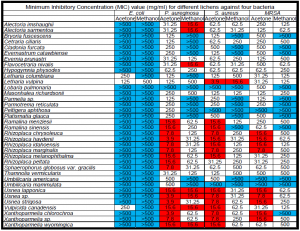Jocelyn Raphael and Dr. Larry St. Clair, Department of Biology
Lichens consist of a fungus occurring symbiotically with a photosynthetic organism (such as an alga and/or cyanobacterium). Lichens are known to produce a high number of secondary metabolites. Studies have shown that these secondary compounds have various biological roles such as antibiotic, antiviral, anti-inflammatory, anti-proliferative, antioxidant, etc. (Huneck, 1999; Molnar & Farkas, 2010). There is a great need for new forms of antibiotics as bacterial infection is an ongoing problem and many bacteria have become resistant to available treatments. To develop new forms of antibiotics many different potential compounds need to be tested. The purpose of this project was to test secondary chemistry extracted from various species of North American lichens (that had never been tested before) against four different bacteria: Escherichia coli, Staphylococcus aureus, Pseudomonas aeruginosa, and Methicillin-resistant Staphylococcus aureus (MRSA).
Testing involved the use the micro-well plate dilution method suggested by Gullace et al (2006) to determine Minimum Inhibitory Concentration (MIC) of the lichen extracts. This was done by preparing a bacterial broth using Muller Hinton Broth and then mixing the broth with solutions that contain different concentrations (3.9 μg/ml to 500 μg/ml) of the various lichen extracts. Both acetone and methanol extracts of lichen chemicals were tested to compare differences between the two extraction procedures. The mixture of lichen extract, broth, and bacteria was then placed in an incubator overnight at 37°C. We then measured bacterial growth using iodonitrotetrazolium chloride (INT) dye which turns pink in the presence of living bacteria. The lowest concentration of lichen extract where no bacterial growth occurs is called the MIC. In other words, this is the lowest concentration of the lichen extract required to inhibit bacterial growth. Therefore a lower MIC value indicates a more promising antibiotic potential. The MIC for each lichen-bacteria combination was carefully recorded in order to determine which lichen extract was most effective against each bacterium.
Originally, I planned to focus on extracts from ten different lichen species, but ended up testing thirty-six species with at least three trials per species. In general acetone extracts were more active against the various bacterial strains than the methanol extracts. Overall, the lichens worked best against S. auerus, MRSA and P. aeruginosa and were least affective against E. coli. These data supported other research based on extracts from other lichen species. Full results are reported in Table 1.
Results for E. coli, S. aureus, and P. aeruginosa were presented in poster format by the graduate student I am working with at a conference for the American Society for Microbiology last summer held at San Francisco, CA. Now we are working on a manuscript of our results to submit in a peer-reviewed journal.
Our research is preliminary, and there is still much to be done on this subject. First, different active compounds within the various lichen species need to be separated out and tested separately. This work is currently being done in my lab on extracts of vulpinic and usnic acid which occur in many of the lichen species currently being tested. Once specific compounds are identified, research needs to be done to pinpoint the mode of action, or the process that the lichen chemical uses to kill the bacteria. Examples of modes of action include rupturing the cell membrane or disrupting protein or nucleic acid synthesis. Once we have sufficient information about the mode of action, testing can then shift to animal testing of the most promising lichen compounds. This step will provide essential information for determining if the compounds are as effective in treating bacterial infections in test animals. Eventually, the most promising lichen chemicals could be used or altered and used as patented drug therapies.
Table 1. Results showing MIC values for each lichen extract in combination with the various bacterial strains. Values above range highlighted in blue. MIC values of 15.6 or below highlighted in red.
References
- Huneck, S. (1999). The Significance of Lichens and Their Metabolites. Naturwissenschaften, 86(12), 559-570. doi: 10.1007/s001140050676
- Gulluce, M., Aslan, A., Sokmen, M., Sahin, F., Adiguzel, A., Agar, G., et al. (2006). Screening the antioxidant and antimicrobial properties of the lichens Parmelia saxatilis, Platismatia glauca, Ramalina pollinaria, Ramalina polymorpha and Umbilicaria nylanderiana. [doi: DOI: 10.1016/j.phymed.2005.09.008]. Phytomedicine, 13(7), 515-521.
- Molnar, K., & Farkas, E. (2010). Current results on biological activities of lichen secondary metabolites: a review. Z Naturforsch C, 65(3-4), 157-173.

